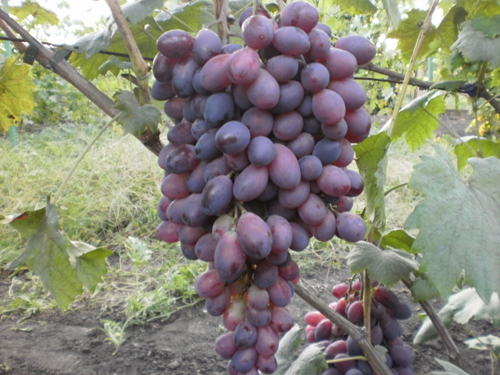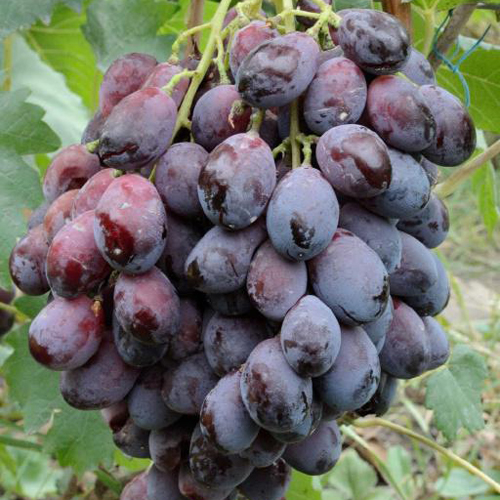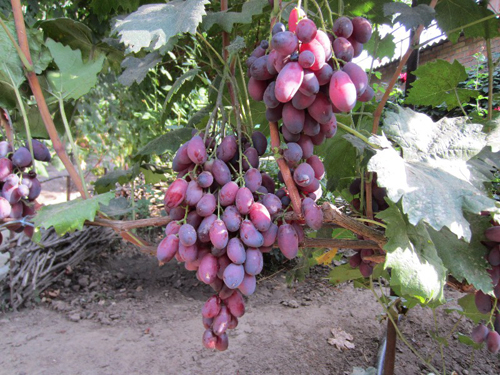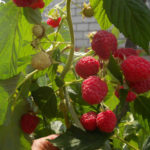Grape variety Asya
A hybrid form of grapes called Asya is a high-quality table variety, bred in the 2000s in Ukraine by the national breeder Vitaly Zagorulko from the Zaporozhye region. An engineer by education and initial occupation, Vitaly Vladimirovich began to cultivate the "sun berry" back in Soviet times, and in the 90s he also decided to engage in experiments on the hybridization of culture. The results of this work were so successful that over time, selection completely captured the attention of the researcher. Thanks to the highest productivity in this field, Zagorulko over the past years has become the author of dozens of his own magnificent brainchildren, which have won the recognition of many amateurs and industrial workers both in his homeland and throughout the post-Soviet space. Many of these hybrids regularly receive awards at industry shows and competitions, and some even managed to pass a strict state test, and, as a result, were included in the official register of varieties recommended for cultivation.

One of the very promising forms is our heroine, obtained by the breeder from crossing the complex-resistant Ukrainian variety Demetra, with excellent beauty and attractiveness of the Dunav fruit, originally from Bulgaria. At the same time, each of the parents passed on their positive qualities to the offspring, as a result of which excellent aesthetic and gastronomic characteristics were combined in Ace with comparative unpretentiousness in cultivation and increased resistance to unfavorable environmental conditions.
A fly in the ointment in this "idyll" is the functionally female type of flowers in the variety. This creates certain difficulties in ensuring full pollination of its inflorescences, requiring the placement of bisexual varieties nearby with sufficient pollen fertility and flowering at the same time. However, these efforts are not in vain, because thanks to them the plants are ready to present their owners with consistently high yields of magnificent grapes.
Agrobiological properties
Growth vigor of own-rooted bushes is high, grafted - medium. The crown of the young shoot is closed, without noticeable pubescence. Young leaves are yellowish-green, with light anthocyanin pigmentation along the edge. A fully formed leaf is large, heart-shaped, usually consisting of five lobes, between which there is a fairly strong dissection. The profile of the leaf blades is wavy, often with drooping edges of the lobes, the surface is smooth, the color is dark green, with light veins that stand out against this background. The upper side cutouts are deep, most often open in the form of a lyre, or slit-like with a pointed bottom. The lower notches are much shallower, usually in the shape of an inclined angle or barely outlined. The petiole notch is wide, vaulted or lancet, less often lyre-shaped with a sharp bottom. Petioles are of medium length, greenish with longitudinal stripes of red tones. The teeth at the edges of the leaves are moderately large, mostly triangular with straight or slightly curved edges and pointed apices. The flowers of the female type, however, in the presence of a number of pollinators, the bunches are formed complete, and the berries are not peeled. Mass shedding of flowers and ovary also usually does not occur. The growth of the current year is ripening fully and on time. At the same time, the vine turns brown with a reddish tint.

Ripening clusters are conical or cylindro-conical, elongated. In length, they can reach 40 centimeters or more, and the average weight ranges from 700 to 1000 grams. The most outstanding of them exceed one and a half kilogram weight. Asya's brush structure is moderately loose, so that the grapes do not crumple under the influence of each other, do not deform or damage. The combs are strong enough to support heavy fruits, long, branchy, light green in color.The berries are very similar in their main parameters to the parent variety Dunav, having a large size, obovate shape and a very elegant red-violet color. Their usual weight is 13 - 14 grams, and their excellent evenness gives the bunch a great appearance. The surface of the grapes is covered with an easily erasable wax layer. The pulp of the fruit is quite dense, fleshy, has a harmonious, typically grape taste, but unfortunately, it does not shine with bright tones in the aroma. The amount of sugars in the juice squeezed from berries is quite good - 17 - 19 g / 100 ml, the titratable acidity is low - 4 - 5 g / l. The skin of the fruit is thin, almost not felt when chewed. The number of seeds does not exceed 2 - 3 pieces. Due to the large volume of grape pulp, the presence of seeds in them does not have a significant negative effect on the taste characteristics, and in general, the hybrid deserves high marks during tasting.
The crop is used primarily for fresh consumption. Excellent presentation allows it to be in high demand among buyers. For this reason, the hybrid is interesting for commercial grape farmers. In addition to the fact that Asya does not stay on the shelves, the producers are impressed by her good transportability, which allows transporting the harvested bunches over long distances without the risk of damage, shedding of berries and deterioration of their appearance. Well, one cannot fail to mention that, referring to the early middle varieties, our heroine manages to ripen before the mass entry of cheap grapes of old varieties on the market, which is also a serious advantage in the eyes of farmers. In private households, amateur winegrowers value the unpretentiousness of the form and its high productivity. Often the surplus harvest is successfully used here in canning, making preserves, compotes, jams and marinades from sweet berries. These products are invariably distinguished by their remarkable fullness of taste and richness of color.

The growing season at Asi usually lasts 120 - 130 days, and in traditional wine-growing regions, harvesting begins at the end of the second decade of August. During the time that has elapsed from the moment the buds bloom in the spring until the onset of removable ripeness, the sum of active temperatures is 2600 - 2700 ° C, which opens up the prospects for cultivating a hybrid for winegrowers in the middle zone of the country with a guarantee of full and annual ripening of the crop. The latitude of such cities as Lipetsk, Tambov and Orel can be considered the northern boundary of the potential distribution area of the variety in the open field. In this case, one should take into account the average frost resistance of our heroine, which does not exceed minus 21 ° C. For this reason, even in the south, it is cultivated with the shelter of plants for the winter, and in case of moving to the north, it is necessary to carry out protection from the cold with special care.
The yield of mature, well-developed bushes is admirable. With good care, they can easily "pull" up to 20 kg of grapes. However, due to the genetically determined large-fruited form and a significant number of brushes laid on the shoots, there is a high risk of overloading the plants. Its most harmless manifestations can be a decrease in the energy of shoot growth, a delay in the maturation of the vine and harvest, the appearance of a watery consistency of berries. If these signs are ignored, the consequences can be more severe, up to the death of bushes, weakened by long-term overloads. To prevent this, a thorough rationing of plants by shoots and harvest should be carried out annually. Spring pruning of fruit arrows is recommended for 6 - 8 eyes, followed by a fragment of fruitless and weak vines. On productive shoots, no more than one brush is left after flowering.
Resistance to fungal diseases is average, and therefore the fight against pathogens can be limited to two or three preventive treatments with fungicides. Berries are damaged by wasps, which many growers protect against by placing the bunches in special bags, where the fruits are safe until harvesting.








